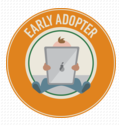 Roughly a year ago I came across an idea that sounded extreme. There was a crowdfunding pitch for a startup that had no team and no idea. What? Well the idea was that the startup once founded would use the ‘Design Thinking’ method to develop the idea and the business model in the first months after funding and company foundation. The pitch was for 100,000 CHF. It had a strange appeal to me, so I invested a small amount. The pitch did fully fun and 4 applicants – students of the university of St. Gallen, Switzerland – were recruited as founders and off they went. The founders are not paid a salary but compensated in shares for their work.
Roughly a year ago I came across an idea that sounded extreme. There was a crowdfunding pitch for a startup that had no team and no idea. What? Well the idea was that the startup once founded would use the ‘Design Thinking’ method to develop the idea and the business model in the first months after funding and company foundation. The pitch was for 100,000 CHF. It had a strange appeal to me, so I invested a small amount. The pitch did fully fun and 4 applicants – students of the university of St. Gallen, Switzerland – were recruited as founders and off they went. The founders are not paid a salary but compensated in shares for their work.
Soon the appropriately named ‘ Design Thinking Startup AG’ was incorporated.
One year of development
As investor I received nearly weekly updates newsletter-style on what the team was currently up to. Through 38 of these reports I was fascinated by successes, drawbacks, ideas and lots of work done. Initially the team sought idea and coaching, used the Design Thinking method to identify problems (needfinding) and did market research. Finally around week 11 one of the ideas substantiated into the idea that was developed.
In between there were events for investors and shareholder meetings approving the decisions proposed by the team.
Then a prototype was built, a development company contracted, the team moved office to Zurich and a second funding round was raised (again through crowdinvesting). During the last weeks the product was presented, tested and finalized in a closed beta.
The result
Last Friday Stablish.me went live. Stablish.me has set itself the goal to redefine the résumé. Further, the company aims to replace it through it’s social endorsement network in the
long term.
Web-profiles as well as classical résumés aren’t necessarily credible. Most people try to highlight how great they are in order to distinguish themselves from the masses. This is
especially true when tough job markets are taken into consideration. There aren’t enough possibilities to show one’s own skills or competencies in an authentic way. Students, young
professionals but also well-established managers are often reduced to their college degrees. As a matter of fact, a lot of people think of an MBA as the only option for a successful career.
“We’re convinced that the talents and skills of people go far beyond the information a classical résumé or professional network profile is able to highlight,†the founders say.
Show appreciation for talents
 Co-workers, friends and network contacts give positive badges on Stablish.me for skills that characterize others. They do so by answering one main question: “What are you really great
Co-workers, friends and network contacts give positive badges on Stablish.me for skills that characterize others. They do so by answering one main question: “What are you really great
at?â€. The badges visualize skills, competencies or personality traits of a user and aggregate on a user’s profile. This allows others to see someones core competencies and expertise at first
glance. Stablish.me also allows it’s user to search for these specific skills. The algorithm is the secret sauce and secures the relevance of search results and the badges shown on a user’s
profile. Our daily interactions will help to keep the profile up-to-date. Stablish.me plans to launch a mobile app by the end of the year. Besides that there will be
an enterprise solution which will help larger enterprises to visualize their employees` broad variety of skills. The ultimate vision is to replace the classical résumé through an authentic and
visualized profile.
It has been fun to watch every step of the startup culminating in the launch. I expect it to be even more exciting to see how company and product fare now that that they interact with users.
